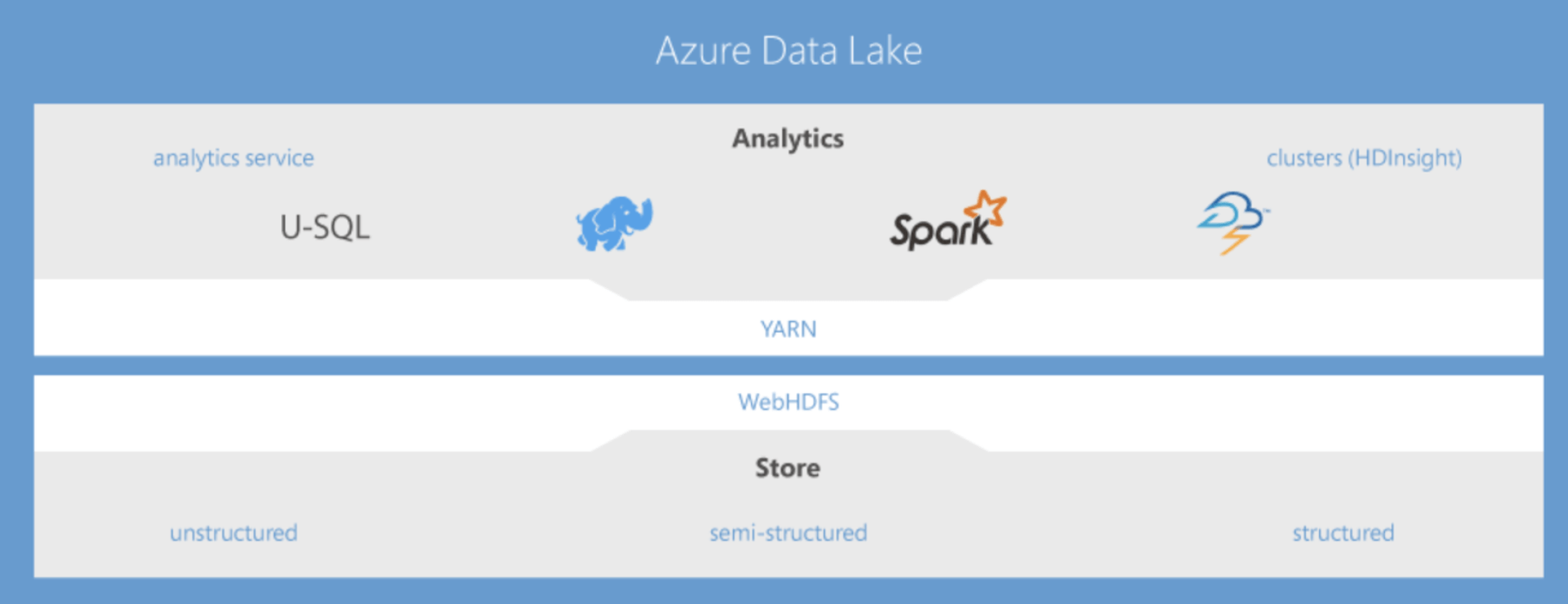What is a Data Lake?
We can define a data lake as a repository to host a massive volume of various types of structured and unstructured data. James Dixon, CTO of Pentaho, came up with a data lake for overcoming the flaws of “data marts.”
The issue with the traditional only data marts approach is that it was only able to find answers to predetermined questions by only examining the subset of the attributes. It does not allow users to get in-depth knowledge and insights from all the available data.
On the flip side, adopting the data lake approach along with traditional investment in data warehouse/data mart does not alter the state of the data and also maintains the three Vs of Big Data: Variety, Volume, and Velocity. Users have all the crucial tools in their arsenal for analyzing, querying, and processing data. Data lakes overcome all the traditional challenges of an old-school data warehouse by decoupling data storage with query engines, offering unlimited space, unlimited file size support, read schema, move once use often along with providing numerous ways to access data, which includes programming using multiple languages, REST calls, and SQL-like queries.
Previously, only huge corporations like Google, Apple, or Yahoo were exploiting advantages of the data lake. Now, the small organizations can also join the party, thanks to innovation like Hadoop (it also includes YARN and HDFS).
What is Microsoft Azure Data Lake?
Modern businesses are sitting on treasure troves of data. The data can be both structured and unstructured and come in various forms like music, social media posts, audio, raw texts, and much more.
Azure Data Lake is a suite of data services available in Microsoft Azure. Data Lake services allow businesses to store, analyze, and manage various forms of data of different sizes. Azure Data Lake product suite provides access to multiple features, such as Spark, Storm, H-Base, U-SQL, and so on. Users can consider their own business requirements and pay as they go.

Azure Data Lake Storage (ADLS)
The first process of data analysis is to upload the data. Azure’s cloud storage has made it incredibly easy for organizations to store their valuable information. Azure Data Lake Storage (ADLS) is a repository that allows organizations to store massive data of unlimited volume. It supports WebHDFS and is therefore compatible with Hadoop File System (HDFS), which has strong user security and is a hierarchical data store.
The latest Azure Data Lake Storage or ADLS version 2 lets you store data in Blob storage via ADLS. It offers every key Blob storage functionality, along with other functions like encryption at rest, data tiering, Azure AD-based permissions, and lifecycle policies. If you want to store high volumes of data, Azure Data Lake Storage is the best service for data storage.
Some of the key offerings of the latest version of ADLS alongside top-notch Blob storage functionality are hierarchical namespace (folders and metadata), Hadoop-compatible file system, and top performance for the massive volume of data processing. This performance can be available to any service, consuming HDFS. It consists of services like HDInsight, Databricks, and ADLA.
Azure Data Lake Analytics
The second core service as part of the Azure Data Lake product suite is Azure Data Lake Analytics. Azure Data Lake Analytics is a compute specific service that can easily connect to and utilize data in ADLS. It offers an immediate analytics service to its users. Users can leverage the analytics service to any scale as per their needs. You can get rid of the huge upfront investment and configuration with this service.
Azure Data Analytics makes use of U-SQL for performing analytical tasks, which is the combination of C# and SQL. Azure Data Analytics provides a platform that allows .NET developers to efficiently process terabytes and petabytes of data, resting on Data Lake Analytics.
Azure HDInsight
Azure HDInsight is the third core component of Azure Data Lake features in the product suite. HDInsight allows users to easily run popular open-source frameworks—including Apache Hadoop, Spark, and Kafka—using Azure HDInsight, a cost-effective, enterprise-grade service for open source analytics.
Microsoft Azure Data Lake Benefits
There are many benefits to using Azure Data Lake. It’s an affordable end to end big data solution that offers affordable storage, data extraction, scaling, and other features needed to manage all the data your business generates. Here are the key benefits of Azure Data Lake:
Extract Data From Any Source
Users have the ability to extract any type of data from structured, semi-structured, to unstructured data via Azure Data Lake with minimal effort. You can get the data from IoT devices, social media platforms, SQL servers, and any other sources as needed. All these types of data will enable you to pull out the best insights from that which was collected.
Utilize Hadoop and Other Intelligent Tools
Hadoop is an application framework that makes it possible to analyze large volumes of unstructured data. The first landing point of unstructured data before moving on to other business intelligence tools is Hadoop. Hadoop processes the data in realtime to help you derive quick conclusions.
Even non-technical users can use Azure Data Lake to utilize Hadoop for the data extraction process. Some of the other powerful tools that you can use on Azure Data Lake are U-SQL, Apache Hive, and Apache Spark.
Pay-As-You-Go
One massive advantage of Azure Data Lake is its flexibility. With a pay as you go model, you won’t have to be locked into long-term contracts and can pay on a monthly basis. The pricing of Azure Data Lake is so minimal that it is even lower than a traditional cloud storage service. It makes it possible for companies to upload massive files with a minimal cost. You can scale your business and upgrade the plan as your business grows.
One-Stop Data Platform
Extracting and compiling data from various services for analytics can be a hectic task. Azure Data Lake allows you to store and analyze all data from its platform without shifting to multiple servers, which will make operations efficient for companies.
Seamless Integration With Microsoft Big Data Platform
Another feature is integration. Azure Data Lake will allow you to combine various features from other Microsoft Big Data services like Azure DataLake Analytics, Azure HDInsights, and Azure Data Factory.
Enterprise-Grade Security
Security plays a significant role when considering the facility to use for a business. Microsoft Azure uses sophisticated technology to protect its platform from various forms of attacks. Many huge corporations trust Microsoft with their valuable data.
How to Use Azure Data Lakes
You’ll explore many ways of using Azure Data Lake when you keep utilizing it over time as your enterprise Modern Data & Analytics solution. Learning how to work with data lakes includes knowing about data uploads, data analysis and reporting.
Uploading the Data
The primary task is to figure out the way to upload data into Azure Data Lake. The most efficient way to upload the information is via Azure Data Factory. It allows you to move and process huge volumes of data from one place to another. It comes up with an improved UI and a Git integration for building pipelines.
Azure Data Lake also supports SSIS package execution for reusing existing investments in the movement and transformation of data.
Performing Batch Data Analysis
You can use HDInsights and Databricks alongside ADLS for batch analysis of unstructured data. Apache Spark SAAs, which Databricks powers, allow you to process data in realtime. On the other hand, HDInsights offers you a wide range of analytics tools like Kafka, HBase, Spark, and so on for a broader analysis.
Reporting in Azure Data Lake
After performing essential data analysis, you may want to use platforms like Cosmos DB, SQL Azure, or your existing BI platform to create a dashboard for reporting.
Data Lake Alternatives
Data Lake isn’t the only set of services that provide modern data architecture options within Azure. Microsoft and other cloud vendors have done a great job of providing a variety of tools that you can deploy as part of your data modernization strategy.
Within Azure, other services like Azure Synapse Analytics (previously Azure SQL Data Warehouse), Azure DataBricks, CosmosDB, and AzureML to name a few can be utilized as a part of modern data architecture.
The question is why should you use one service over another? Many factors influence that decision including cost, culture, maturity aspirations, and skillsets.
Conclusion
Azure Data Lake is an advanced cloud platform that empowers organizations to join the data-driven business world. There are various pricing packages that make its services affordable to both small and large organizations as per their needs.
Companies can use its simple, yet powerful user interface to take advantage of Big Data technology and use Azure data lake analytics features to generate unique insights and trends to gain competitive advantage.
Productive Edge is a digital strategy and technology solutions consulting first that helps organizations accelerate their digital transformation. To learn more about how Productive Edge can help your business get the most out of Microsoft Azure Data Lake, contact us to book a free consultation.





